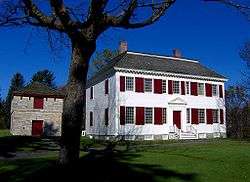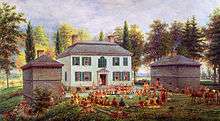Johnson Hall State Historic Site
|
Johnson Hall | |
 | |
|
Johnson Hall State Historic Site, 2006 | |
 | |
| Location | Johnstown, New York |
|---|---|
| Coordinates | 43°0′54″N 74°22′58″W / 43.01500°N 74.38278°WCoordinates: 43°0′54″N 74°22′58″W / 43.01500°N 74.38278°W |
| Built | 1763 |
| Architect | Peter Harrison (1716-1775) |
| Architectural style | Georgian |
| NRHP Reference # | 66000520 |
| Significant dates | |
| Added to NRHP | October 15, 1966[1] |
| Designated NHL | October 9, 1960[2] |
Johnson Hall State Historic Site was the home of Sir William Johnson (1715–1774) an Irish pioneer who became the influential British Superintendent of Indian Affairs in the Province of New York, known for his strong relationship especially with the Mohawk and other Iroquois League nations.
The house was built seven miles from the Mohawk River, close to Hall Creek. Hall Creek provided water sufficient to power a sawmill and later a grist mill. Built of wood, the house frame was covered with wood planks intended to simulate stone. Johnson engaged leading colonial architect Peter Harrison (1716-1775) to design the house; he hired the carpenter, Samuel Fuller, to build it.[3] At least some of the ideas for the house came from the Builders' Companion magazine. Johnson also had two block houses built as defenses against attack on the frontier, as the British had just ended the Seven Years' War with the French.
Johnson founded Johnstown, New York, and came to own a 400,000-acre (160,000 ha) estate. Johnson moved here from Old Fort Johnson in 1763 and lived here until he died in 1774. The house was inherited by his son, John Johnson. During the American Revolution, the rebel government in New York seized Johnson Hall because the Johnsons had gone to Canada as Loyalists. In 1779 the state sold the house to Silas Talbot, a migrant from New England.[4]
It was used as a private residence by various owners until 1906, when the state bought it for preservation and interpretation as a house museum of the most important colonial landowner in the state. It received restoration in the early twentieth century and in the 1950s, to remove additions of the late nineteenth century and better reflect its original time. The historic site includes more than 18 acres of land.[4]
The house was declared a National Historic Landmark in 1960.[2][4]
Johnson Hall is located at Hall Avenue, West State Street and Johnson Avenue, in Johnstown, New York.
Gallery
-

modern painting of older event at Johnson Hall
-

Johnson Hall State Historic Site, August 2005
References
- ↑ Staff (2007-01-23). "National Register Information System". National Register of Historic Places. National Park Service.
- 1 2 "Johnson Hall". National Historic Landmark summary listing. National Park Service. Retrieved 2007-11-16.
- ↑ Hamilton, Milton W. (1976). Sir William Johnson: Colonial American, 1715–1763. Port Washington, New York: Kennikat Press. p. 313. ISBN 0-8046-9134-7.
- 1 2 3 Charles H. Ashton and Richard W. Hunter (October 15, 1984). "National Register of Historic Places Inventory-Nomination: Johnson Hall National Historic Landmark" (pdf). National Park Service. and Accompanying 14 photos, exterior and interior, from 1984. PDF (2.96 MB)
External links
- Official website
- Historic American Buildings Survey (HABS) No. NY-3107, "Johnson Hall, Johnstown, Fulton County, NY", 17 photos, 2 data pages, supplemental material
- HABS No. NY-392, "Johnson Hall, Blockhouse", 2 photos, 4 measured drawings, supplemental material
- Revolutionary War Heritage Trail: Johnson Hall State Historic Site, Heritage New York
| |||||||||||||||||||||||||
| ||||||||||||||||||||||||||||||||||||||||||||||||||||||||||||||||||||||||||||||||||||||||||||||||

